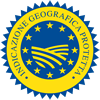Description
Amarene Brusche di Modena PGI is a preserve obtained from the following varieties of sour cherries: Amarena di Castelvetro, short-stalked Amarena di Vignola, long-stalked Amarena di Vignola, Amarena di Montagna, Amarena di Salvaterra, Marasca di Vigo, Meteor, Mountmorency and Pandy.
Production Area
The production area of Amarene Brusche di Modena PGI preserve is in the valleys and medium-high hills of several municipalities in the provinces of Modena and Bologna, in the Emilia Romagna region.
Production Method
The fruits must be processed according to the traditional recipe. The classic method is “concentration through the thermal evaporation of the fruit”, which requires the fruit to be fully ripened when processed. Due to their limited shelf life, the sour cherries must be chilled within two hours of harvesting and transformed within 24 hours, in order to maintain their qualitative characteristics and avoid abnormal fermentation. The cherries are generally harvested between May 20th and July 31st. The fruit are destoned and destalked; after the addition of sucrose, which must be a minimum of 35% of the product’s weight, the fruit are left to rest at 60-80 °C for at least 30 minutes before the final transformation process. The use of colourings, preservatives, additives or thickeners is prohibited, as are any other sugars apart from sucrose; these regulations are aimed at offering a completely traditional high-quality product.
Appearance and Flavour
Amarene Brusche di Modena PGI preserve has a soft consistency and a reddish-brown colour with dark highlights. The flavour is characterised by a good balance between sweet and sour, which distinguishes it from other preserves.
History
Sour cherry preserve is part of Modena’s ancient gastronomic traditions. Its origins date back to the Renaissance and its production in the region is documented in many literary works. In L’arte di ben cucinare et istruire, written by Bartolomeo Stefani in 1662, there is mention of a recipe for sour cherry preserve. At the end of the 19th century, Pellegrino Artusi included a recipe for a typical tart made with sour cherry preserve in his cookbook La scienza in cucina e l’arte di mangiar bene, writing that their sharp flavour gave the tart a unique connotation. At first it was a niche crop, but at the end of the 19th century, cherry cultivation began to find ideal conditions on the land between the provinces of Modena and Bologna. It gradually became an intensive cultivation, with a large increase in production.
Gastronomy
Amarene Brusche di Modena PGI preserve must be kept in its original packaging, in a cool, dry place; once open it should be kept in the refrigerator. It has an unusual sour taste and can be eaten either on its own as a dessert, or used to make tarts and cakes. It pairs particularly well with ice-cream. A traditional Modena dessert is the Crostata di Marene, a tart made with short crust pastry and covered with Amarene Brusche di Modena PGI preserve: the combination of the very sweet pastry and the sourness of the preserve, give it an unmistakable and unique taste.
Marketing
The product is marketed as Amarene Brusche di Modena PGI. It is packaged in glass or tin-plated recipients with a capacity ranging from 15 to 5000 ml.
Distinctive Features
Amarene Brusche di Modena PGI preserve has unique organoleptic properties, given to both the variety of sour cherry used and the high percentage of fruit, which constitutes at least 70% of the finished product.



















